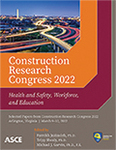Data Analytics and Computational Thinking Skills in Construction Engineering and Management Education: A Conceptual System
Publication: Construction Research Congress 2022
ABSTRACT
Data analytics and computational thinking are essential for processing and analyzing data from sensors, and presenting the results in formats suitable for decision-making. However, most undergraduate construction engineering and management students struggle with understanding the required computational concepts and workflows because they lack the theoretical foundations. This has resulted in a shortage of skilled workforce equipped with the required competencies for developing sustainable solutions with sensor data. End-user programming environments present students with a means to execute complex analysis by employing visual programming mechanics. With end-user programming, students can easily formulate problems, logically organize, analyze sensor data, represent data through abstractions, and adapt the results to a wide variety of problems. This paper presents a conceptual system based on end-user programming and grounded in the Learning-for-Use theory which can equip construction engineering and management students with the competencies needed to implement sensor data analytics in the construction industry. The system allows students to specify algorithms by directly interacting with data and objects to analyze sensor data and generate information to support decision-making in construction projects. An envisioned scenario is presented to demonstrate the potential of the system in advancing students’ data analytics and computational thinking skills. The study contributes to existing knowledge in the application of computational thinking and data analytics paradigms in construction engineering education.
Get full access to this article
View all available purchase options and get full access to this chapter.
REFERENCES
AbouRizk, S., Halpin, D., Mohamed, Y., and Hermann, U. (2011). “Research in modeling and simulation for improving construction engineering operations.” Journal of Construction Engineering and Management, 137(10), 843–852.
BLS (Bureau of Labour and Statistics). (2019). “Employment by detailed occupation.” <https://www.bls.gov/emp/tables/emp-by-detailed-occupation.htm>. (June 11, 2021).
Burnett, M. M., and Myers, B. A. (2014). “Future of end-user software engineering: beyond the silos.” Proceedings of the on Future of Software Engineering, 201–211.
Chilana, P. K., Singh, R., and Guo, P. J. “Understanding conversational programmers: A perspective from the software industry.” Proc., Proceedings of the 2016 CHI Conference on Human Factors in Computing Systems, ACM, 1462–1472.
Clarke, T., Ayres, P., and Sweller, J. (2005). “The impact of sequencing and prior knowledge on learning mathematics through spreadsheet applications.” Educational Technology Research and Development, 53(3), 15–24.
Dixon, T., Connaughton, J., and Green, S. (2018). “Understanding and Shaping Sustainable Futures in the Built Environment to 2050.” Sustainable Futures in the Built Environment to 2050: A Foresight Approach to Construction and Development, 337.
Edelson, D. C. (2001). “Learning‐for‐use: A framework for the design of technology‐supported inquiry activities.” Journal of Research in Science teaching, 38(3), 355–385.
Forum, W. E. Shaping the Future of Construction: A Breakthrough in Mindset and Technology. World Economic Forum Cologny, Switzerland.
Greeno, J. G. (1998). “The situativity of knowing, learning, and research.” American psychologist, 53(1), 5.
Greeno, J. G., and Engeström, Y. (2006). Learning in activity, Cambridge University Press, Cambridge, England.
Ko, A. J., Abraham, R., Beckwith, L., Blackwell, A., Burnett, M., Erwig, M., Scaffidi, C., Lawrance, J., Lieberman, H., and Myers, B. (2011). “The state of the art in end-user software engineering.” ACM Computing Surveys (CSUR), 43(3), 21.
Lave, J., and Wenger, E. (1991). Situated learning: Legitimate peripheral participation, Cambridge university press.
Letondal, C. (2006). “Participatory programming: Developing programmable bioinformatics tools for end-users.” End user development, Springer, 207–242.
Lieberman, H. (2001). Your wish is my command: Programming by example, Morgan Kaufmann.
Omar, T., and Nehdi, M. L. (2016). “Data acquisition technologies for construction progress tracking.” Automation in Construction, 70, 143–155.
Scaffidi, C., Shaw, M., and Myers, B. “Estimating the numbers of end users and end user programmers.” Proc., 2005 IEEE Symposium on Visual Languages and Human-Centric Computing (VL/HCC'05), IEEE, 207–214.
Shyamala, C., Velayutham, C. S., and Parameswaran, L. “Teaching computational thinking to entry-level undergraduate engineering students at amrita university.” Proc., 2017 IEEE Global Engineering Education Conference (EDUCON), IEEE, 1731–1734.
Wang, A. Y., Mitts, R., Guo, P. J., and Chilana, P. K. “Mismatch of expectations: How modern learning resources fail conversational programmers.” Proc., Proceedings of the 2018 CHI Conference on Human Factors in Computing Systems, 1–13.
Information & Authors
Information
Published In
History
Published online: Mar 7, 2022
Authors
Metrics & Citations
Metrics
Citations
Download citation
If you have the appropriate software installed, you can download article citation data to the citation manager of your choice. Simply select your manager software from the list below and click Download.
